Embark on the dynamic landscape of online learning as we explore the booming market, the success stories of giants like Coursera and Udemy, and delve into the essential steps to develop an e-learning platform. Unlock the potential of your educational venture with WeSoftYou.
Key Takeaways:
- Online Learning Market Growth: Witness the staggering growth projections of the online courses market, expected to reach $25.33 billion by 2025.
- Success Stories: Compare the growth and strategies of e-learning giants Coursera and Udemy to glean insights into the evolving EdTech industry.
- Platform Development: Discover the architecture and tech stack considerations for building a successful e-learning platform, with a focus on backend, frontend, database, and cloud system.
- MVP Features: Uncover the must-have features for a successful e-learning website, including categories and filters, teacher-student profiles, course creation, and more.
- Cost Estimation: Gain insights into the estimated cost of creating an e-learning platform, considering factors like team size, functionality, and customization.
- Development Challenges: Explore challenges in e-learning website development, from communication with universities to data protection and user experience.
- Monetization Strategies: Define effective monetization strategies for your e-learning platform, including free learning, paid certificates, subscriptions, and premium accounts.
- Market Research: Emphasize the importance of thorough market research to tailor your platform to user preferences, demographics, and learning goals.
- WeSoftYou’s Experience: Trust WeSoftYou’s expertise in e-learning development, showcased through projects like gamified cybersecurity training and a content management system for circular economy initiatives.
Udemy vs Coursera Story Success
Numerous e-learning websites have shown rising graphs, showing that demand has increased along with the number of courses, students, income, and investments. The giants of modern e-learning, Coursera and Udemy, still keep their positions. Let’s compare their growth and tactics within the last three years and see what insights we can get from them.
Overall net worth growth
Coursera’s revenue in Q3’22 was $136.4 million, 24% more compared to $109.9 million a year ago. Udemy reported 22% year-over-year to $158.4 million in Q3’22 and 57 million learners. Likewise, with more than 113 million members, Coursera is currently valued at over $2.3 billion. Meanwhile, the recent Udemy valuation resulted in $3.7 billion.
Content
Coursera mostly collaborates with colleges and institutions. Harvard, Stanford, Princeton, Yale, and 149 other illustrious universities from 29 countries are just a few of the institutions that work with Coursera. As a result, Coursera presents a major challenge to traditional education by offering the caliber of the best colleges at a competitive price. Additionally, Coursera students who cannot pay the fees can request financial aid.
Udemy, on the contrary, works with individual teachers who contribute content to the website. 213,000 courses, or 40 times more than Coursera’s database of courses, are estimated by Udemy. However, their online courses are often short-term and developed by independent teachers, not necessarily university professors. Nevertheless, all courses are verified before being released. Udemy offers all the resources required to build and market a course for profit.
Certified academics
Both Coursera and Udemy cooperate with reputable universities and teachers with a degree. On Coursera, this rule is especially strict: it works with 275 universities, which, image-wise, contributes to the exclusiveness of the brand. Udemy works with schools too, but this platform also allows individual teachers to start working. Currently, they work with 74 000 instructors.
| Coursera | Udemy | |
| Valuation | $2.3 billion | $3.7 million |
| Users | 113M | 57M |
| Courses | 5.2K | 213K |
| Certificates | Paid | Paid |
| Degrees | Yes | No |
| Languages | 10 | 75 |
| Partners | 275 universities | 74 000 instructors |
| Course price | $29-99 | $20-200 |
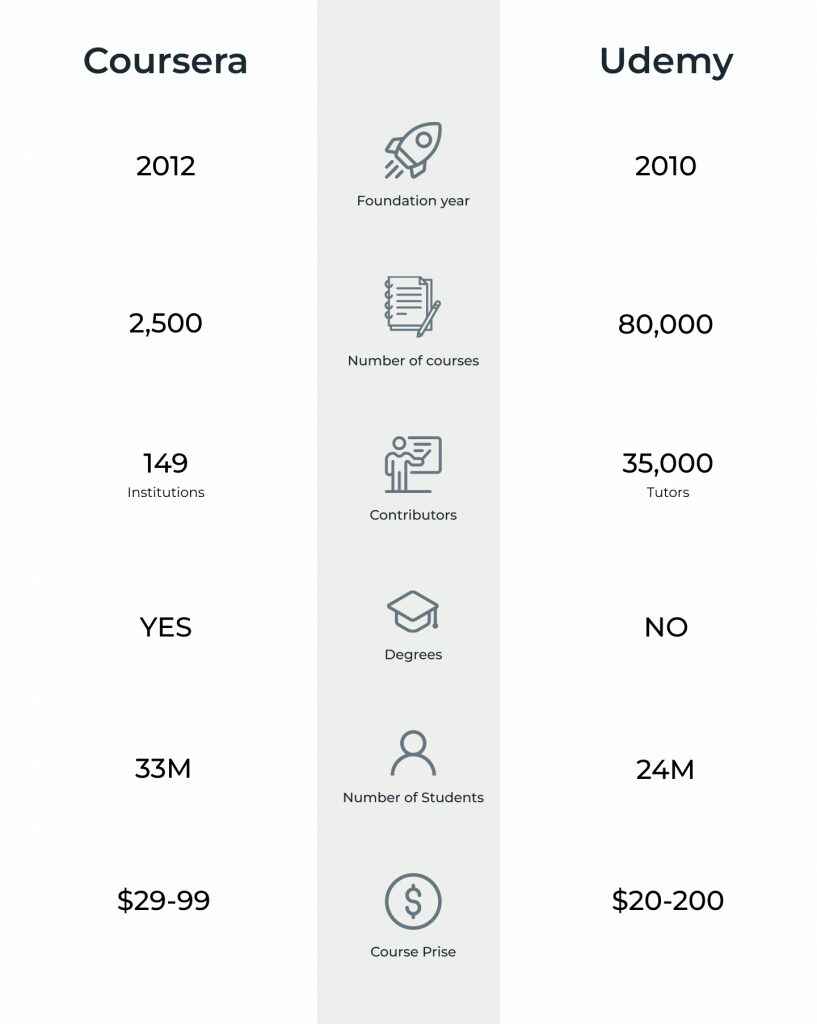
Online Learning Platform Architecture & Tech Stack
The matter of selecting technology while creating an e-learning platform like Coursera is vital. It affects the timing and price of the development process, user experience, and the platform’s scalability. Let’s talk about the technology in more detail to help you analyze them and make a proper choice for your EdTech solution.
Backend
In the creation of Coursera and Udemy, the common backend denominator was Python. While this programming language allows flexibility and scalability, our alternative recommendation will be Node.js. Thanks to its adaptability and lack of overload issues, this technology, which is included with the NestJS framework, will enable you to build a server-side of the app. NestJS framework is great for e-learning solutions thanks to being open-source, lightweight and simple.
Front-end
Provided how responsive, multifunctional, and intuitive e-learning marketplace has to be, the best solution for front-end development would be React for websites and React Native for mobile apps The key benefits of such a stack include code reusability, live reload (a feature allowing engineers to see and work with changes in real-time), and third-party plugins easy integration.
Database
Relational databases, like MySQL or PostgreSQL, are the best choice for creating Coursera-like sites thanks to their speed and versatility. MySQL is efficiently creating storage for all data the e-learning website has to include: text, images, videos, workbooks, and payment details, which is why both Coursera and Udemy included it in their tech stack.
Cloud system
In terms of cloud systems, a great choice can be AWS. It’s the most extensive one on the market, startup-friendly (as it offers free annual plans for those taking part in their program), and multifunctional. Thanks to its vast array of services, this foundation allows its users to select the operating system, programming language, database, and web application platform.

E-Learning Website MVP Features
To build an e-learning website properly and make sure it will be popular on the market, you should incorporate a variety of must-have features into the MVP. Let’s look at the list of education app-specific musts more closely.
Categories and filters
Whatever your potential students’ learning choice is, they must have a chance to browse through desired courses and make a pick among the related categories. Give your potential clients a chance to range or exclude courses by different criteria, helping them find the right course within minutes.
Teacher and student profiles
Make sure to design convenient dashboards for both students and teachers. Let the students see their purchases, enrollments and activities. Additionally, it would help to include a list of active and completed courses, purchases and transactions records, certificates, user info, profile settings, and a wishlist.
Teacher profile feature implementation differs within different online learning marketplaces. For instance, you can follow Udemy’s example, where every enrolled teacher receives an instructor profile, where they may design and upload their classes using a user-friendly platform. On the contrary, Coursera only permits course creation for teachers qualified at one of its 275 partner institutions.
Course creation
On Udemy and Coursera, course creation is possible thanks to the course creation wizard. It’s possible to create a course structure, write a script, add videos, slides, text, quizzes, coding exercises, assignments, practice exams, and other materials like PDFs, links, audio files, etc., using the tool.
Cloud integration and syncing
Syncing and cloud integration is a necessary feature since it helps access information using different devices. Both teachers and students will have a chance to make their process more convenient, be it studying on a train with a tablet or checking homework with the help of a laptop.
Offline mode
It’s probable that students won’t have a consistent, dependable internet connection at any one time. The ability to access all relevant material at any time will make learning easier and increase user retention if an offline mode is made available.
How Much Does It Cost to Create a Website Like Udemy or Coursera in 2024?
Back-end and front-end developers, designers, QA testers, and project managers are all needed to create an e-learning website. Let’s dive into more detail concerning the approximate time frame and price for creating an e-learning platform.
he cost of building an e-learning platform ranges from $25,500 to $100,000, depending on customization. Along with dashboards, attendance and timetable management, database, and test formats, the MVP also offers fundamental app functions. Must-have MVP features include categories and filters, teacher-student profiles, course creation, cloud integration, and offline mode for enhanced user experience. A customized product will also comprise language modification, mock testing, social sharing, etc. at the same time.
The size of the team, the functionality required, and whether a bespoke product or an MVP is being developed all play significant roles in the time and cost estimation. WeSoftYou may provide more precise numbers upon request, as each project should be estimated independently.
Challenges of E-Learning Website Development
Like any product development, building an e-learning website has a range of challenges. Let’s see what they may be and how to overcome them.
Communication with universities
How to make an e-learning platform like Coursera? The answer is to communicate and partner with learning institutions and schools you want to represent on the platform. This is probably the biggest milestone from the project management point of view, but it can be accomplished with proper marketing and PR teams.
Sensitive data protection
While developing e-learning software, ensuring the security of sensitive student and teacher information, as well as protecting the platform against cyber attacks, is another milestone to achieve. To ensure data safety, it’s necessary to use secure hosting, implement SSL certificates, and conduct regular security audits to ensure the platform’s security.
Integration with Learning Management Systems (LMS)
Integrating the platform with existing LMS and third-party tools for tracking progress and assessing student performance is a very responsible technical task. Make sure to trust it to proven professionals. Additionally, choose an LMS that integrates well with the e-learning platform you’re using, or consider using an open-source LMS like Moodle.
User experience (UX)
Creating a seamless and user-friendly interface that offers a rich learning experience is both an adventure and a challenge. A well-thought-out UX is crucial because it works toward user retention. If the website and its functions are clear and naturally lead users to their goal, they will stay with this product and recommend it to others.
To succeed in this venture, conduct user testing, research the latest web design trends, and consider using a responsive design to ensure a great user path and user stories.
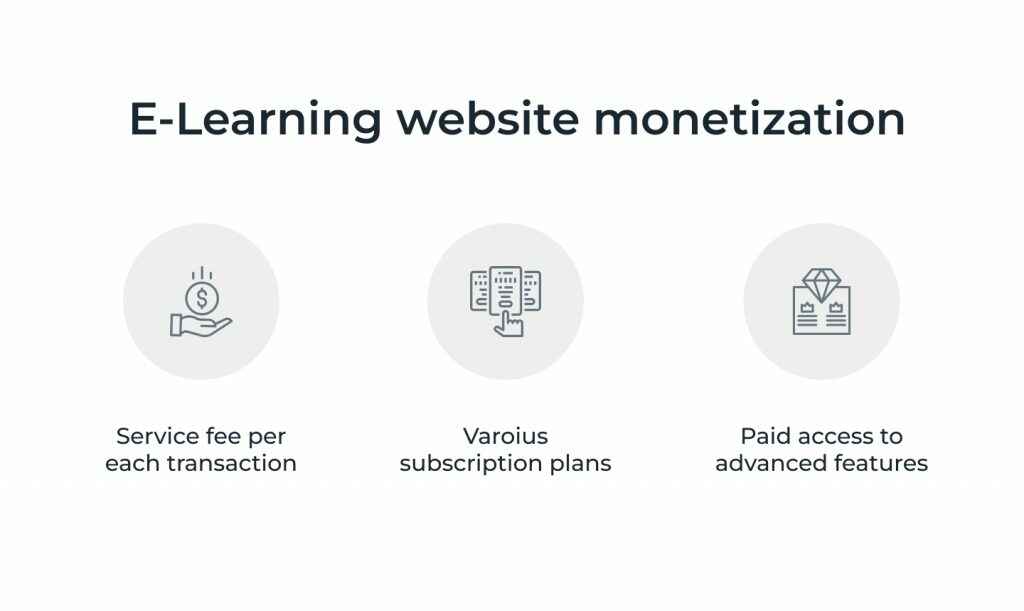
3 Things to Consider When Building an E-Learning Platform
It’s essential to take into account the following when building an e-learning website.
Define monetization strategy
An educational platform is a type of product where not every way of monetization like product placement or direct advertising will be appropriate. However, there are lots of monetization alternatives that will be compatible with this format.
Free learning, paid certificates
At the dawn of its first years, Coursera came up with a sophisticated way of monetization, which came across as a very fair compromise: students have the entire access to a given course. However, getting its completion certificate costs a certain fee.
Such a monetization strategy is appealing as it gives learners the freedom of choice and incentivized voluntary payment.
Subscription
For a set fee, learning platforms like Udacity provide students access to thousands of resources. You can implement monthly or yearly billing. However, you’ll have to work on a price-setting aspect of this strategy.
Premium accounts
For a set charge, upgrading an account may grant access to more classes or the opportunity to download lessons and study offline. Alternatively, you can offer a range of other functions that will make learning even more convenient.
Pick a niche
To make an e-learning platform that will find success on the market, it’s critical to thoroughly think about the type of educational content the given platform will provide. Will it cover a variety of topics or will they be specialized for a specific market and industry? Will it be a platform with free admittance to teaching, or will you only work with proven scholars? Answering this and other audience-specific questions is crucial before starting development, which brings us to the next point.
Research the market
A market analysis is crucial in developing a potentially popular e-learning platform. Determine what users want and how they behave, define their educational background, age, gender, and origin. The next step would be to rethink their goals and learning preferences; finally, take into account their already-existing skills.
It’s much simpler to provide tailored and practical material that will satisfy their demands when you are aware of the learners and their interests.
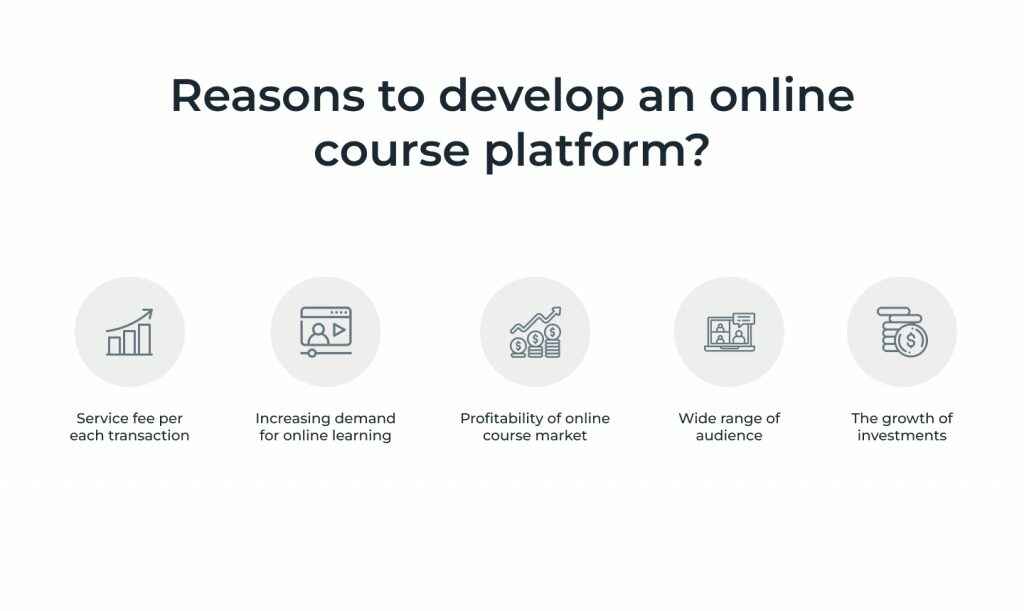
WeSoftYou Experience in E-Learning Development
Trust WeSoftYou as your next online education web development provider. As a custom e-learning software developer with over three years of expertise, we provide turn-key educational solutions for every need, working in adaptable engagement models.
Security training, gamified
A Fortune 500 web platform called Living Security offers gamified cybersecurity e-learning. It provides immersive cyber security training through an “escape room”-style experience.
The WeSoftYou team developed the first fully remote human risk management platform for cyber security and contributed to the digitalization of existing security awareness training. We helped over 1000 businesses globally train employees to manage their internet data safely
The WeSoftYou team uses Python, Django, Serverless, Postgres, Celery, and Redis for backend development. With the help of ReactJS, Redux, Styled Components, and Typescript, the front-end was completed. The leaderboard, reporting, games, and LS and business admin panels are among of the app’s main features.
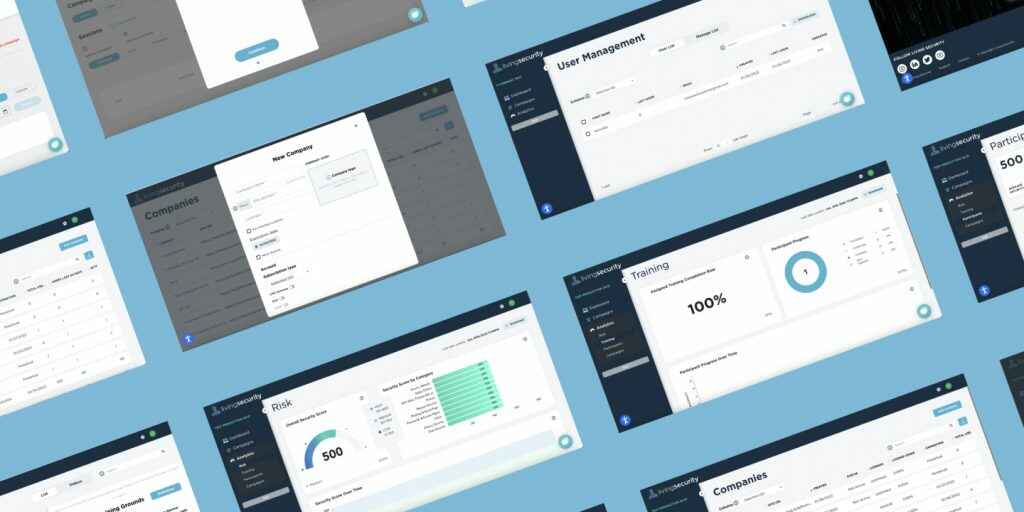
Content management system for e-learning
Circle Economy, a social enterprise, creates industrial systems that are regenerative by design by isolating development from resource needs. The company is working to speed the shift to a circular economy by providing insights into what a circular future might look like for a company or a region and by creating scenarios for how to get there.
The WeSoftYou team had a number of tasks to complete on this mission, including developing a microservice architecture for the platform’s web app, integrating it with the infrastructure and services provided by AWS, customizing a headless CMS, and integrating it with elastic search, archiving historical data by altering articles and cases, and using third-party services as an authorization system.
Python, Django, React, AWS, and Elastic were the frameworks used by the WeSoftYou team on this project. As a result, we delivered a site with case studies on the circular economy, frameworks for circular strategies, and policy instruments, which may be used as models for fresh projects.
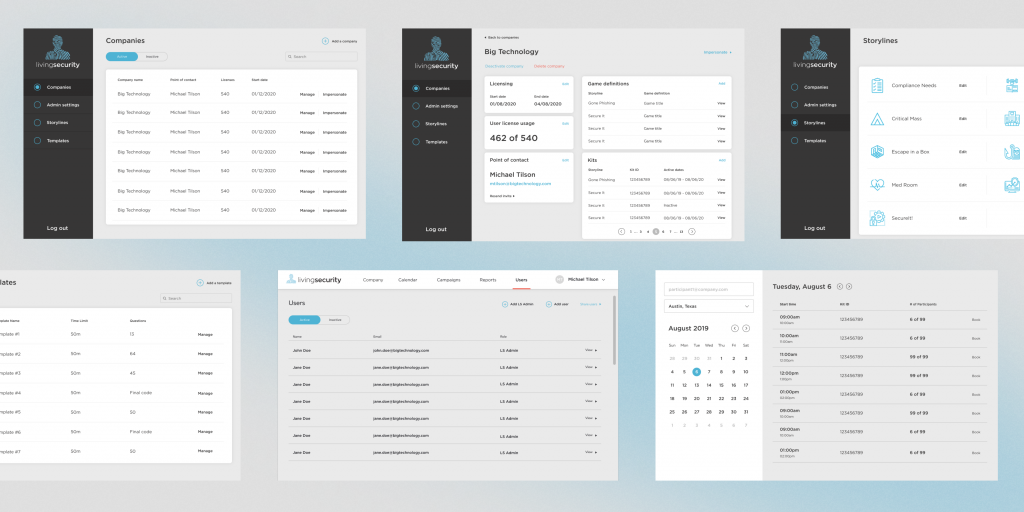
Develop an E-Learning Platform Like Udemy with WeSoftYou
Do you want to reap the benefits of educational applications? They are plenty: faster employee training with reduced time and costs for businesses or a seamless learning experience for schools and colleges, not to mention the profitable online learning sector. Then it’s critical to pay attention to proper communication with schools and market research, carefully think out monetization, and pick a proper development team.
Trust the team at WeSoftYou with developing an e-learning website for you. We provide smart solutions that open online education to anyone, be it corporate or school-based e-learning software, instructional management platform, or another EdTech product. Let’s talk about your next idea: we will consult you on the e-learning platform development and work together to choose a solution fitting your needs.
FAQ
Yes, building an e-learning platform in 2023 can be profitable. The e-learning market has experienced significant growth in recent years and is expected to continue to grow in the future due to the increasing demand for online education. With the rise of remote work and online learning, the e-learning industry is expected to reach over $325 billion by 2025.
However, profitability depends on various factors, such as the target audience, niche, and competition. To increase the chances of profitability, it is important to offer a high-quality platform with user-friendly features and engaging content, differentiate from the competition and effectively market the platform to your target audience.
To create an e-learning website like Udemy, you should be ready to spend $70,000 to $135,000, which is an average market rate. This will involve project management, custom web design, QA testing, and work development from the discovery phase. The cost normally varies according to the complexity of the features and integrations.
Before spending too much time and money, you can always launch your platform quickly and start with the essential features (as an MVP). This will allow you to test the concept.
The success of the Coursera platform can be explained by different factors. First of all, Coursera lets students have full access to a particular course, but they must pay the price to receive their completion certificate. Thanks to this, a single MBA course generated more than $20 million in revenue through certificate sales.
Secondly, Coursera only works with 275 reputable universities, contributing to the platform’s brand image as a quality education provider.





















